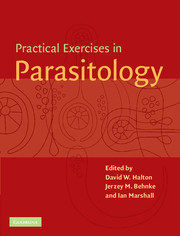Book contents
- Frontmatter
- Contents
- List of contributors
- Preface
- General advice
- 1 Observational Exercises on Parasites
- 2 Ecology
- 3 Physiology and Biochemistry
- 4 Pathology and Immunology
- 4.1 Encapsulation of foreign matter (not-self) by earthworms
- 4.2 Opsonisation of trypanosomes
- 4.3 Production and screening of monoclonal antibodies against Leishmania promastigotes
- 4.4 Pathological effects of Mesocestoides corti and Schistosoma mansoni
- 4.5 Quantification of lymphocyte populations in the spleen and thymus
- 4.6 Use of basic indirect ELISA for the detection of antibodies produced by experimental immunisation
- 4.7 SDS PAGE and Western blotting for the detection of antibodies produced by experimental immunisation
- 5 Chemotherapy
- 6 Molecular Parasitology
- 7 Behaviour
- Appendix 1 Reagent index
- Appendix 2 UK suppliers
- Appendix 3 US suppliers
- Index
4.6 - Use of basic indirect ELISA for the detection of antibodies produced by experimental immunisation
Published online by Cambridge University Press: 05 June 2012
- Frontmatter
- Contents
- List of contributors
- Preface
- General advice
- 1 Observational Exercises on Parasites
- 2 Ecology
- 3 Physiology and Biochemistry
- 4 Pathology and Immunology
- 4.1 Encapsulation of foreign matter (not-self) by earthworms
- 4.2 Opsonisation of trypanosomes
- 4.3 Production and screening of monoclonal antibodies against Leishmania promastigotes
- 4.4 Pathological effects of Mesocestoides corti and Schistosoma mansoni
- 4.5 Quantification of lymphocyte populations in the spleen and thymus
- 4.6 Use of basic indirect ELISA for the detection of antibodies produced by experimental immunisation
- 4.7 SDS PAGE and Western blotting for the detection of antibodies produced by experimental immunisation
- 5 Chemotherapy
- 6 Molecular Parasitology
- 7 Behaviour
- Appendix 1 Reagent index
- Appendix 2 UK suppliers
- Appendix 3 US suppliers
- Index
Summary
Aims and objectives
This exercise is designed to demonstrate:
The use of Enzyme Linked Immunosorbent Assay (ELISA) for the detection of antibody produced by experimental immunisation.
The induction of an immune response to a parasite antigen.
The change in antibody titre during an immunisation programme.
Introduction
One of the most widely used immunoassays in parasitology is the ELISA. This technique was developed in the 1970s as a quantitative and sensitive assay of antibodies during responses to parasitic infection, but can also be adapted to quantify circulating and faecal antigens. When dealing with parasitic infections, it is important to be able to detect the type of antibody response in terms of class and subclass, which may give some indication of resistance or susceptibility (Hagan et al., 1991). In addition, the ELISA is a useful tool for the detection of antibodies produced by experimental immunisation.
Fig. 4.6.1 shows the various components involved in a standard indirect ELISA. The antigen is bound onto a plastic microassay plate and any free sites are then blocked to prevent non-specific binding. The antiserum is added and, if any antigen-specific antibodies are present in the serum, they will bind to the plate. A second antibody, conjugated to an enzyme that recognises the first class of antibody, is then added. If the primary antibody recognised the antigen in the previous step, the secondary antibody will bind to the primary antibody.
Information
- Type
- Chapter
- Information
- Practical Exercises in Parasitology , pp. 283 - 292Publisher: Cambridge University PressPrint publication year: 2001
